Green roofs are not an object, but a complicated and complex system. According to Green Roofs for Healthy Cities, “A green roof system is an extension of the existing roof which involves, at a minimum, high-quality waterproofing, root repellent system, drainage system, filter cloth, a lightweight growing medium, and plants” (Green Roofs for Healthy Cities, n.d.). Simply stated, green roofs consist of vegetation placed on a roof, and infrastructure beneath the vegetation to support it and the roof/building below it.
Green Roof Components
1. There are six main layers of a green roof: the waterproofing membrane, the root protection layer, the drainage layer, the filter layer, the substrate layer, and the vegetation layer. Each layer of the green roof serves an important and unique purpose. The vegetation layer is the most varying and customizable aspect of the system. It consists of either grasses, plants, shrubs, crops, or trees. Its components and layout depend on the purpose of the green roof, and the design parameters outlined by the roof’s planner. A myriad of plant options exist within the vegetation layer and are dependent on the roof’s microclimate (media depth, solar levels, water availability, etc.) and its relation to the climate of the surrounding area. Ideally, green roof plants should be long-living, self-spreading, and should contain shallow root systems. Commonly used plants include sedums, moss, perennials, shrubs trees, and lawn. Generally speaking, succulents are a popular choice due to their ability to store excess water. Figure 16 includes a table of recommended plants for green roofs in urban areas with similar climates to Easton.
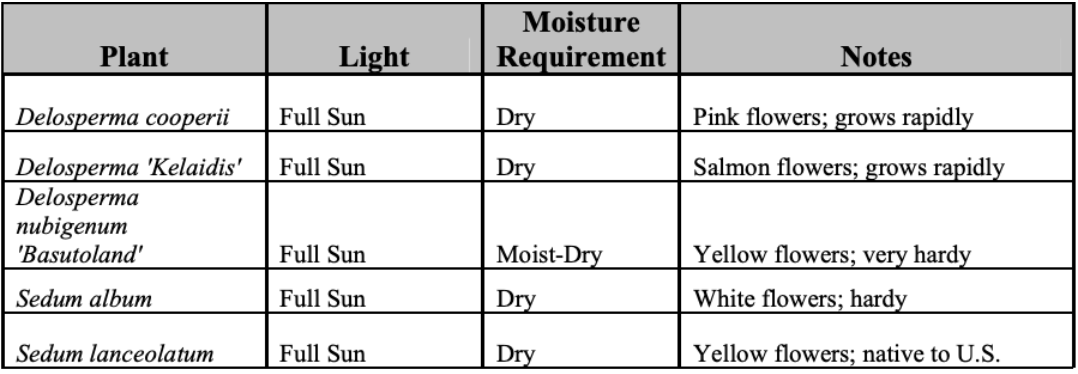
Figure 16. Ground covers appropriate for green roofs in the District of Columbia. Adapted from The Benefits and Challenges of Green Roofs on Public and Commercial Buildings by the United States General Service Administration, 2011.
2. The growing medium is found above the filter layer and is responsible for supporting the layer of vegetation and its roots. Additionally, the growing medium is the source of water to sustain the vegetation as well as the main source of stormwater retention and detention, so its thickness has a direct reflection on the green roof’s stormwater retention. The selection of specific material for growing medium varies abundantly, each material satisfying the following requirements: it satisfies the needs of the plants it supports, it must not pose excessive weight on the underlying structure, and it must provide an optimum balance between retention and drainage. Suggestions for the specific components of this medium are provided in ranges to account for differences in the plant, roof, and building needs. Roughly a 4:1 mixture of a mineral such as expanded clay and a lighter substance such as pearlite is used, and dried to contain about 20% aerated pore space, 40% water holding capacity, and 40% solid mixture of a mineral and a lighter substance. The ideal density for this mixture is five pounds per square foot per square inch. This will roughly retain 0.4 inches of rainfall per square inch of medium. One necessary consideration is the general lack of nutrients in such an inorganic material. To account for this, owners may need to use slow-release fertilizer which provides necessary minerals. Additionally, when constructing a green roof it is necessary to evaluate the surrounding climate and vegetation (Pérez, Vila, Rincón, Solé, & Cabeza, 2012).
3. Above the drainage layer is the filter layer in a green roof, which is responsible for allowing water to flow freely to the drainage layer while containing the growing medium and vegetation. Additionally, the filter layer prevents the drainage layer from getting clogged by trapping particles from the substrate layer (Vegetal i.D, n.d.). Polypropylene fabric is the most commonly used material because it is water-permeable, decay-resistant, inexpensive, tough, and durable. Variations within this layer are infrequent, however, one gaining popularity is a system combining the filter layer and drainage layer. A failure within the filter layer could cause clogging of the drainage layer and roof drainage system which may cause irreparable damage to the building beneath (Vegetal i.D, n.d.).
4. Above the protective layer of a green roof is its drainage layer, which is a porous material that allows water to flow from the green roof system to the roof’s drainage system. The effectiveness of this layer is important to protect the roof from pooling and potential structural damage but is also affected by the filter layer and the growing medium chosen. There are two main types of drainage layer used. The first is a granular material such as pebbles, or plastic in a similar shape to account for weight. The second type of drainage layer used is a mat of spongy, webbed material which releases water once it becomes saturated. The robustness of this layer and the material used are dependent on the use of the roof and its orientation. For example, a nearly flat roof necessitates a thicker drainage layer to ensure water drains away from the roots of plants properly and does not drown them. Additionally, some drainage layers hold a certain amount of water to ensure the vegetation does not die. Drainage layers for some intensive green roofs are capable of incorporating irrigation systems to water more delicate vegetation. In Easton, due to the high frequency of flooding, a thicker drainage layer would be ideal to mitigate excess stormwater. This is especially true in floodplains where stormwater becomes flood water more quickly as the ground gets more saturated. Vegetation is much more effective at absorbing latent heat and therefore mitigating the urban heat island effect if it is not saturated with water. This is dependent on the effectiveness of the drainage layer (Center for Watershed Protection, 2013).
5. The layer after the waterproofing membrane is the protective layer (also known as the root barrier layer), which acts as a barrier between the roots of plants and the roof and waterproofing membrane below. One strategy for effectively separating these two layers is to provide a physical distance between the roots and the waterproofing, which is often done using layers of Polyvinyl chloride, welded PVC, or, more conservatively, plastic or metal trays elevated from the surface of the roof. This elevation can be invaluable in providing a physical distance which does not allow roots to reach the roof. Another, newer option within this layer is the use of a chemical root inhibitor which stops the growth of roots past a certain point. Although it has proven to be effective in several case studies, the existing presence of chemical pollutants in Easton’s runoff suggests a physical barrier may be more suited for the city (Roof Protection, n.d.).
6. The first distinction which must be made while initially considering the installation of a green roof is the condition of the existing roof membrane. Most roofs are designed to be weatherproof, and are typically effective in protecting against the elements. However, for a roof to support consistent standing water, it must be waterproofed. This requires a higher standard of care and a thicker roof membrane. As green roofs become more common, some roofs are being built to be easily retrofitted for green roofs by including waterproofing and a more robust drainage system. However, due to the age of most buildings in Easton, it is likely that waterproofing and a more robust drainage system will be necessary to implement (Vegetal i.D, n.d.).
The diagram below in Figure 17 visualizes the green roof layers.
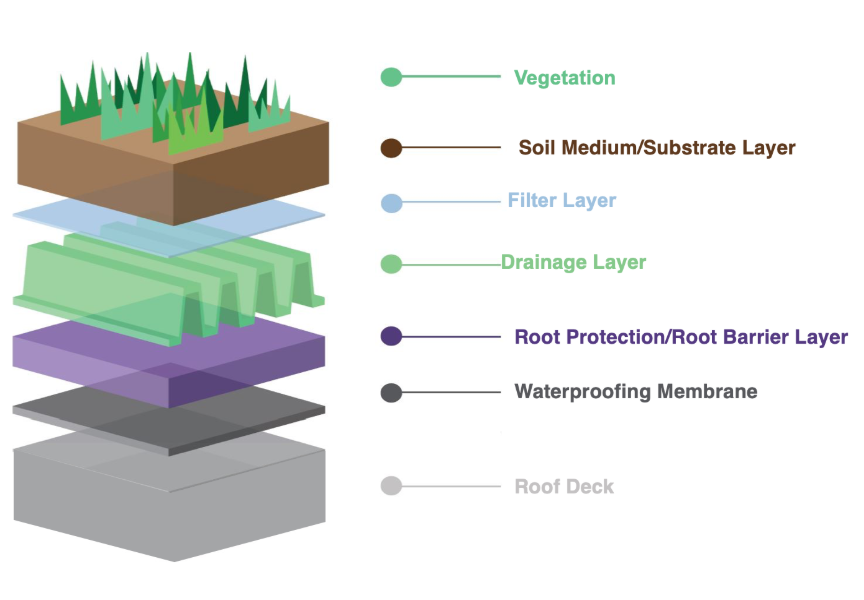
Figure 17. A description of the layers of Green Roofs. Adapted from Green roofs as a tool for solving the rainwater runoff problem in the urbanized 21st century?, Mentens, J., Raes, D., & Hermy, M, 2006. Edited by Authors.
Private Benefits of Green Roofs
For individual buildings or households where green roofs have been implemented, the main benefits include decreased energy use, increased roof membrane longevity, and improved acoustic insulation.
Energy Reduction in Heating and Cooling:
Green roofs reduce energy consumption in space heating in a multitude of ways: shading, evapotranspiration, insulation, increase in thermal mass, and reduction of heat loss through radiation. In the winter, green roofs can be more efficient in preventing heat loss than conventional roofs. An experiment in Ottawa found that a 6-inch extensive green roof reduced heat gains by 95% and reduced heat losses by 26% compared to a conventional roof. Another study conducted by Florida Solar Energy Center found that 18% of the energy that was used for space cooling was saved by a green roof compared to a conventional roof. That number increased to 44% when the plants were more established (Feng, 2018).
Membrane Longevity:
There are three ways in which green roof technology increases the lifespan of a building’s roof: by protecting it against diurnal fluctuations, UV radiation, and thermal stress. Studies have shown that green roofs can lengthen the lifetime of a roofing membrane between 40 and 50 years. On the other hand, conventional roof’s have lifespans that range between 10 and 30 years (Feng, 2018).
Acoustic Insulation:
By increasing absorption, green roofs improve the soundproofing of a building and reduce the sound reflection. For buildings located near very strong sources of noise, such as Route 22 which crosses Easton’s downtown, green roofs can be extremely helpful. One of the most common methods used to improve noise insulation is applying an extra layer of plasterboard into the ceiling. The benefits from green roofs are similar and often times exceed those of the extra layer of plasterboard since there are multiple layers in a green roof (Feng, 2018).
Public Benefits of Green Roofs
In addition to the individual benefits, there are many public benefits, such as the reduction of stormwater runoff, the improvement of air quality, and the mitigation of the urban heat island effect.
Reduction of Stormwater Runoff:
Green roofs can have a significant impact on the stormwater retention capacity of buildings. Traditionally, rainwater flows off of a building’s roof and into the sewers quickly, but with the implementation of green roofs, it slows down significantly since they can retain some of the water. Sewer systems capacity requirement can be lowered by using green roofs since they can hold as much as 50% – 95% of the annual precipitation depending on the regional climate (Feng, 2018).
Improvement of Air Quality:
The vegetation plays a very crucial role in the green roof. It actively absorbs many pollutants and passively filters and directs airflow, thus reducing air pollution. A study conducted in Toronto, Canada found that by implementing 109 hectares of green roofs, eight metric tons of unclarified air pollutants can be removed per year. Additionally, a study conducted in Chicago, Illinois estimated that 1,645 kilograms of air pollutants can be removed by 19.8 hectares of green roofs (Feng, 2018).
Mitigation of the Urban Heat Island Effect:
As mentioned earlier, in urban areas, much of the natural vegetation and landscape has been replaced by impervious surfaces. The dark surfaces, such as roads, reflect less solar radiation and absorb more energy. A simulation study in New York found that if 50% of the roof area is covered with vegetation, the average roof temperature can be reduced by as much as 0.8 degrees Celsius. In Toronto, Canada, it was estimated that the urban heat island effect can be reduced by 12 degrees Celsius if only 6% of the city was covered with green vegetation. In the Mediterranean region, green roofs can save between 10% and 14% of the electrical energy consumed in cooling residential buildings. However, it is important to realize that green roof performance in reducing the urban heat island effect is different depending on the location due to factors such as climate (Feng, 2018).
Extensive and Intensive Green Roofs
There are some universal requirements for green roof plants. First, the plants cannot have invasive roots because these could puncture the system. Additionally, they cannot be too heavy in order to satisfy the maximum load bearing capability of the roof (Grant & Jones, 2008).
Generally speaking, there are two main classifications of green roofs: intensive green roofs and extensive green roofs. While not all green roofs fit perfectly into this categorization, the two work to satisfy differing wants and needs and work to improve different aspects of the natural environment. Both intensive and extensive green roofs have significant environmental benefits. They both help improve stormwater runoff, improve air quality, and reduce the urban heat island effect.
Intensive green roofs are often intended for human interaction. Therefore, they are more in the form of a garden with pathways and thus are often times a source of food. Additionally, they serve as space for people to gather, similar to a park. With this additional human interaction, intensive green roofs must be designed to sustain the additional weight from human foot traffic as well as the plants and trees. Therefore, these green roofs are almost exclusively installed on concrete roof frames. Similarly, intensive green roofs can only be installed on flat roofs. Since intensive green roofs are meant for interaction, they require frequent maintenance. Routine work includes watering the plants, cutting the shrubs, or even harvesting the crops. The complete intensive green roof system can weight between 102 and 410 pounds per square foot. Additionally, the substrate layer is typically at least 12 inches thick (Vegetal i.D, n.d.). Overall, although intensive green roofs are heavy and typically expensive, some of the unique features are the wide variety of wildlife, a community gathering spot, a source of food, and their visual appeal. Figure 18 shows an example of an intensive green roof and Figure 19 shows an example of an extensive green roof.
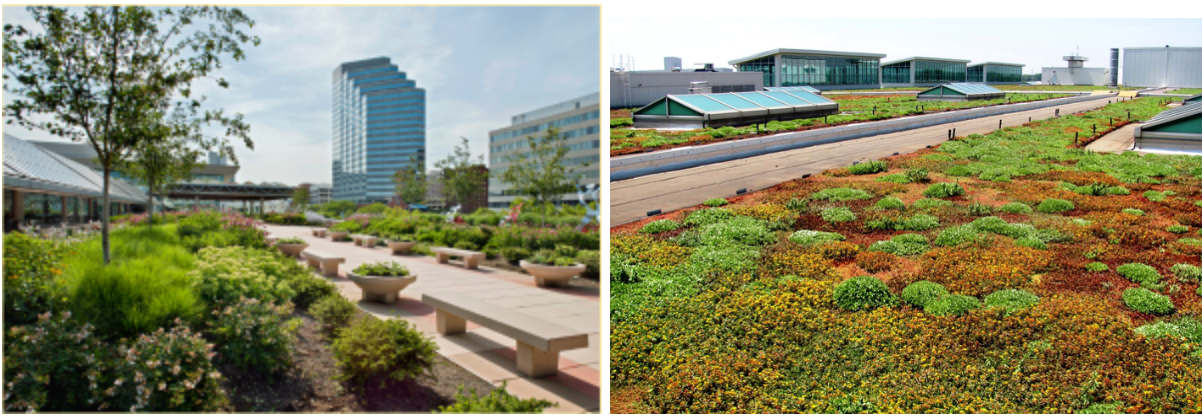
Figures 18 and 19: Figure 18. An Example of an Intensive Green Roof with Specific Areas for Community Members to Gather. Adapted from Baltimore Convention Center, Greenroofs.com, 2018 Figure 19. An Example of an Extensive Green Roof. Adapted from Extensive versus Intensive – Which Would You Choose?, by Yurek, 2013.
Extensive green roofs are vastly different than intensive green roofs. They are not intended for human interaction and take the form of a mostly self-maintained system. Extensive green roofs typically do not include plants that require maintenance, but rather opt for species that are drought resistant and self-sufficient (Grant & Jones, 2008). Some of the common choices are sedums, moss, and perennials (Vegetal i.D, n.d.). Since extensive green roofs are not intended for people to interact with, they are much more versatile than intensive green roofs. They can be installed on roofs with slopes in addition to flat roofs. Extensive green roofs are significantly lighter than intensive green roofs, weighing between 15 and 37 pounds per square foot (Vegetal i.D, n.d.). This makes it much more feasible to retrofit an existing building with an extensive green roof than an intensive green roof. In addition to the lightweight system, there is very little, possibly even no, maintenance required. Furthermore, extensive green roofs do not require as thick of a substrate, typically between 2 and 6 inches (Vegetal i.D, n.d.). Overall, some of the unique features are the low maintenance requirements, versatility to retrofit existing roofs, and relative lightweight. The table below, Figure 20, further explains the differences between extensive and intensive green roofs.
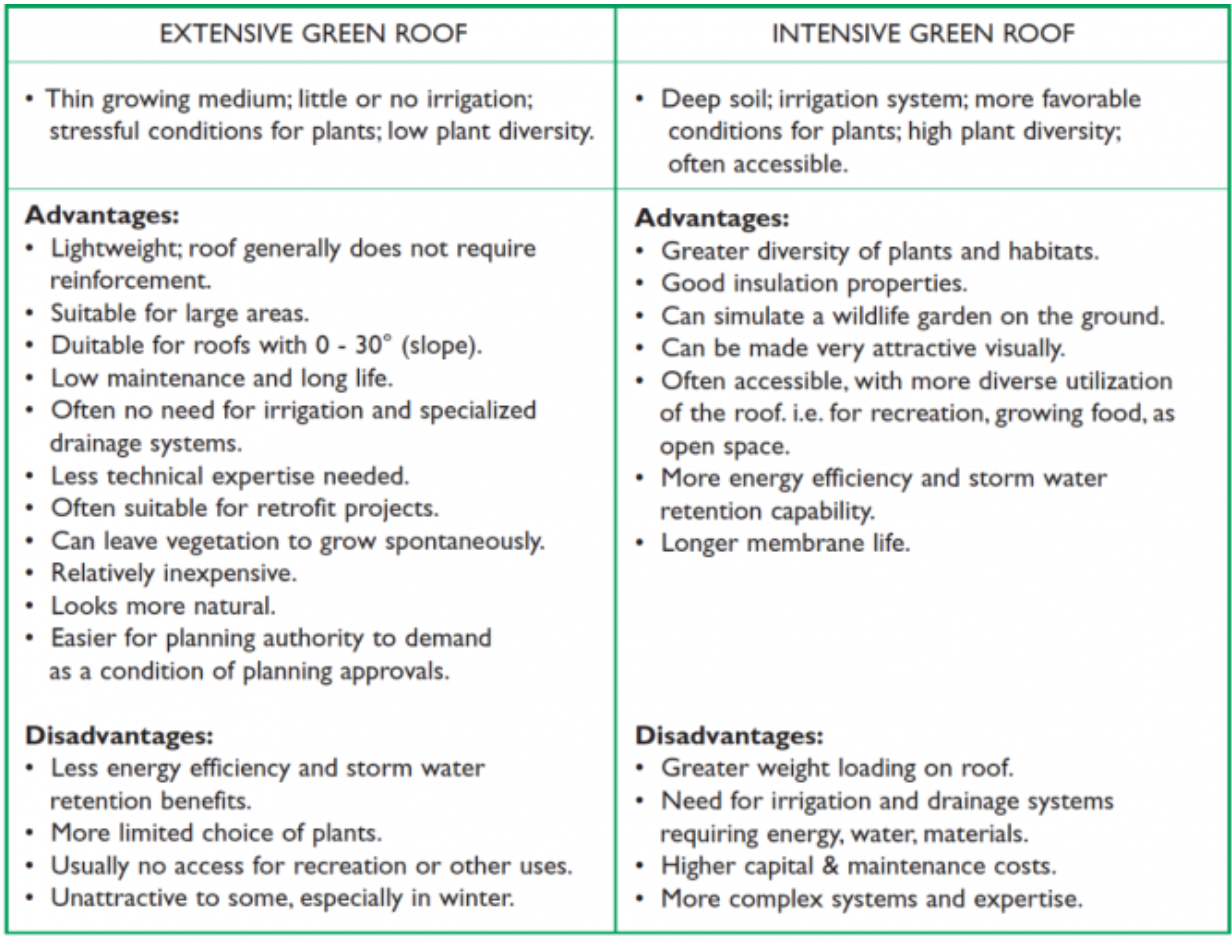
Figure 20. Comparison of the advantages and disadvantages of extensive and intensive green roofs. Adapted from Design Guidelines for Green Roofs., S. Peck, S., & M. Kuhn, M., 2016.
Overall, most of the differentiation between intensive and extensive green roofs stem from their different purposes, and thus the vegetation choice. Since extensive green roofs are almost strictly for environmental benefits, the most common choices are sedums, moss, and perennials because they are able to flourish in harsh environments (Vegetal i.D, n.d.). On the other hand, since intensive green roofs are intended for human interaction and are therefore maintained, there is a much wider choice of vegetation options. Choices range from shrubs, grasses, large perennials, and even small trees (Step Digital, 2016).
In addition to having physical differences in size, weight, and material, intensive and extensive green roofs can also address a variety of different community concerns. These concerns include flooding, water quality, stormwater runoff, access to food and air quality, but vary by district because of the distinctly heterogeneous nature of Easton. This indicates that the best decision-making framework would take into account the different needs of different communities within Easton, and how those needs might best be satisfied by green roofs of different styles (Frankel & Goldman, 2017).
Conclusion
Green roofs are a complex system and, at a minimum, are made of the following components: the vegetation, the growing medium, the filter layer, the drainage layer, the protection layer, waterproofing. There are benefits for both the individual building owner as well as the general public. Some of the private benefits include decreased energy use, increased roof longevity, and increased acoustic insulation. In contrast, the public benefits include the reduction of stormwater runoff, improvement of air quality, and the mitigation of the urban heat island effect. The two main classifications of green roofs are intensive and extensive. Intensive green roofs differ from extensive green roofs in that they are designed for human interaction. Intensive green roofs often include gardens, pathways, and can be used as a source of food. Extensive green roofs are considered a self-maintained system but still yield significant benefits due to its versatility. These benefits include its low maintenance, ability to be installed on sloped roofs, and relatively small weight. Each green roof is unique and the specific layers of the green roof must be catered to each building’s differing context and specifications. This element of green roofs adds significant variability to their costs, which will be further explained in the economic context of this report. Figure 21, below, demonstrates the variability of factors that should be considered during green roof design.
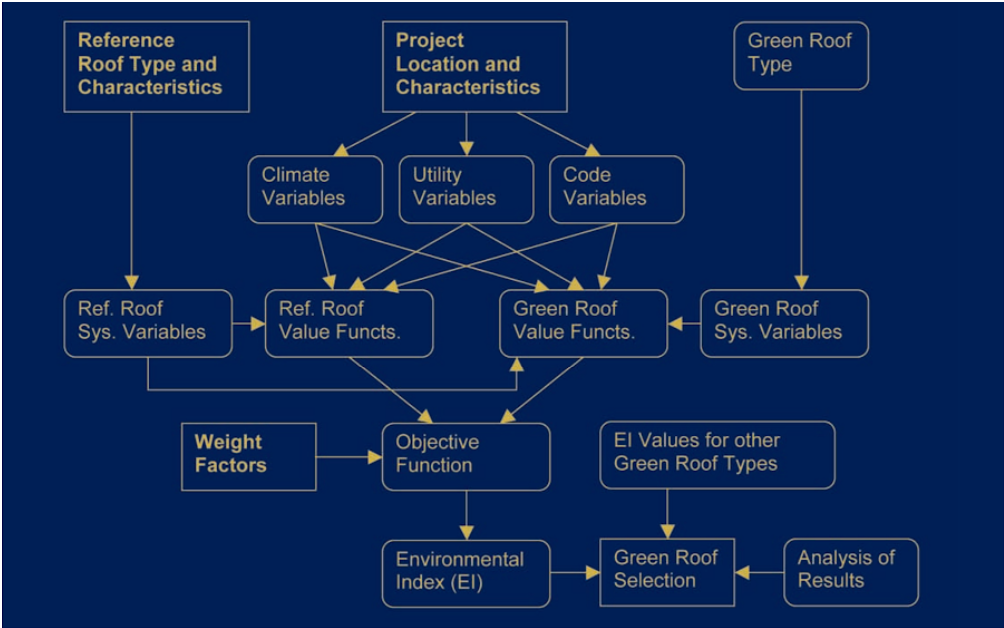
Figure 21. A flowchart showing the sequence of variables that need to be considered for green roof design. Adapted from A decision-making framework for vegetated roofing system selection, by Grant, E. J., & Jones, J. R., 2008.
To read the Economic Context section of our report, click here.